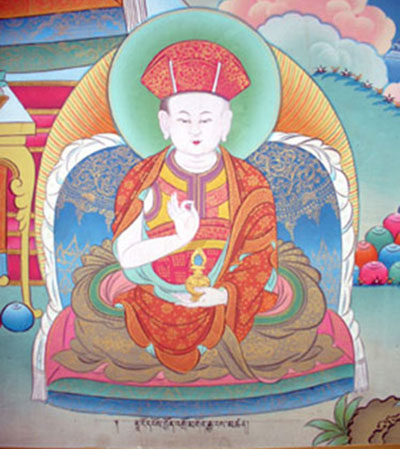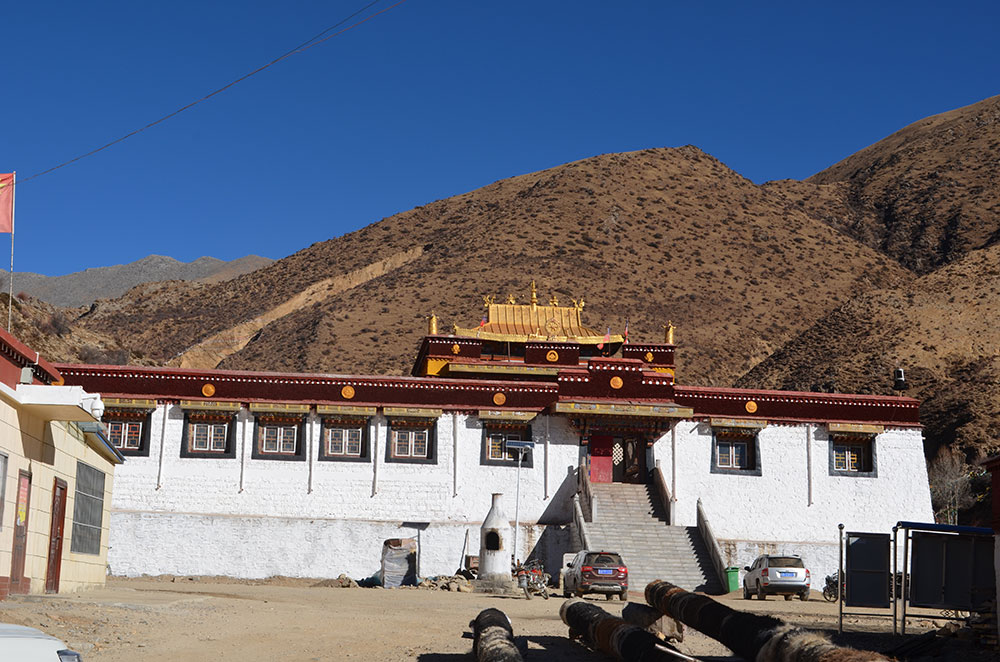Part 1: The texts and context of Tsangpa Gyare and his tradition
Since its founding as a nation-state in the seventeenth century by the lineage holder of the Drukpa order, the peerless Zhabdrung Ngawang Namgyel (1594-1651), Bhutan has been renowned throughout the world as ‘Druk-yul’. It is popularly translated as the ‘Land of the Thunder Dragon’ or the ‘Land of the Drukpa school’. Zhabdrung Rinpoche was the hereditary hierarch of the two monasteries of Druk and Ralung, as well as the reincarnation of Tsangpa Gyare Yeshe Dorje (1161-1211). The latter was the founder of the Drukpa Kagyü school and the eponymous figure after whose tradition Bhutan took its glorious name of ‘Druk’.
Based on the findings of a Kyoto University research team led by Associate Professor Seiji Kumagai, this three-part article series will help reconstruct the biographical details of Tsangpa Gyare’s life and legacy. This will be done through an analysis of his vast, but scattered Sungbum (collected works) and Namthars (biographies), which were written by different biographers from different historical periods.

We would like to firstly give a general introduction of these source materials that elucidate critical facts of his life and legacy; secondly of the biographical details of his life itself; and third and finally, his substantive legacies like a vast network of peerless Drukpa monasteries, hermitages and practitioner communities. All these will be done by contextualising the details of Tsangpa Gyare’s life from his many textual corpuses into the socio-political fabric of Bhutan, where his tradition has had a fundamental role in shaping the country’s national character and culture.
The Kyoto team has accessed the three oldest biographies of Tsangpa Gyare, composed by his three direct disciples (Dremowa Sangyebum, Marton and Lorepa), which are indispensable primary sources for systematically understanding his life and legacy. These biographies have now been published by the Centre for Bhutan and GNH Studies as a critical edition (with extensive annotations and editorial notes) for use by both academic and general readers.
There are three versions of the collected works of Tsangpa Gyare from Bhutan, Nepal and Ladakh, which respectively include different works.
Modern academic scholars such as Dan Martin, W. B. Miller and Seiji Kumagai have introduced and studied this figure in several academic papers. However, the absence of a critical edition collating the various known early biographies and collected works of Tsangpa Gyare has delayed a full-scale study of this important figure.
Buddhism was formally introduced into Tibet at the beginning of the 7th century, specifically, during the reign of King Songtsen Gampo (581/618-649). It became the state religion in Tibet during the reign of Trisong Detsen (742-797). Thereafter, from its cradle, this religion spread to its surrounding regions such as in present-day Mongolia, Bhutan, Sikkim and other Tibetan cultural areas.
Among the four prominent Tibetan Buddhist schools, the Kagyü school produced the most numbers of sub-schools such as Karma Kagyü, Drikung Kagyü and Drukpa Kagyü. The latter spread in surrounding regions and became the state religious school in Bhutan.
The Kyoto researchers have endeavoured to collect different biographies and collected works of Tsangpa Gyare. There are seven versions of the biography of Tsangpa Gyare that were composed by different people offering sometimes differing versions and chronologies of events. As said earlier, three of them were composed by his direct disciples.
There are at least five different traditions regarding Tsangpa Gyare’s previous lives. Even the two authoritative religious histories (Choejung) of Bhutan give variable versions. For example, the ‘Lhorong Choejung’ by the 10th Je Khenpo, Panchen Tenzin Chogyal, enumerates that the incarnate line as Naropa→Shadhaka→Dewe Junne→Tsangpa Gyare. However, the ‘Lhodruk Choejung’ by the 69th Je Khenpo merely states it as Naropa→Gampopa→Tsangpa Gyare.
All the traditions other than Pema Karpo start from Naropa, but the reincarnations from Naropa to Tsangpa Gyare differ across various traditions. It can be noted that the biography composed by Marton is similar to the ‘Lhodruk Choejung’ and an anonymous biography is similar to the ‘Lhorong Choejung’.
What about the future reincarnations of Tsangpa Gyare? His next reincarnation was the 13th abbot of the Drukpa Kagyü school, Gyalwangje Kunga Penjor (1428-1476), who was active more than 200 years after him.
After the death of Gyalwangje, Jamyang Chokyi Drakpa (1478-1523) was confirmed as the third reincarnation of Tsangpa Gyare. The fourth reincarnation, Pema Karpo (1527-1592), was called “the omniscient” (Kuenkhen) as he was one of the greatest scholars not only of the Drukpa Kagyü school, but across Tibet generally.
After the passing away of Kuenkhen Pema Karpo, there occurred a conflict between two candidates for the fifth reincarnation. One was the 17th hereditary hierarch of the Drukpa Kagyü school, Zhabdrung Ngawang Namgyel, who belonged to the revered Gya clan. The other was Pagsam Wangpo (1593-1641), the son of an influential leader in the Chonngye region.
The governor of Tsang arbitrarily intervened in the conflict and recognised Pagsam Wangpo as the formal reincarnation of Pema Karpo. As a result, Zhabdrung moved from Ralung Monastery to Western Bhutan in order to avoid a protracted conflict. The Drukpa Kagyü school was divided into the Northern Drukpa Kagyü school (Jangdruk) and the Southern Drukpa Kagyü school (Lhodruk).
The Northern Drukpa Kagyü school has continued the reincarnation line up to the current (12th) reincarnation of Tsangpa Gyare, Jikme Pema Wangchen (1963-).
In the Southern Drukpa Kagyü school, Zhabdrung Ngawang Namgyel established a nation state called Druk Yul (that is, “the country of the Drukpa school”), which is alternatively called Bhutan or Bhootan by Europeans.
The positions of Druk Desi and Je Khenpo, which were respectively in charge of the politics and religion of the state as postulated by Zhabdrung in his later years, remained even after his Parinirvana in 1651. Gongsar Ugyen Wangchuck (1862-1926) reconstituted the sovereignty of the country into a dynastic monarchy by establishing the Wangchuck dynasty in 1907 as the supreme upholder of the dual spiritual and temporal tradition of the glorious Drukpa.
Having ascertained Tsangpa Gyare’s reincarnation lines in his previous and succeeding lives, let us now historically map Tsangpa Gyare by focusing on the lineage of master and disciple from the origin of the main Kagyü tradition to its most outstanding sub-school, the Drukpa Kagyü.
Drukpa Kagyü is a sub-school derived from the Dagpo Kagyü school attributed to Gampopa (1079-1153). The lineage of Dharma was transmitted from Marpa (1012-1097) to Milarepa (1052-1135), Gampopa, Phagmo Drupa (1110-1170), Ling Repa (1128-1188) and finally to Tsangpa Gyare.
Ralung Monastery which was established by Tsangpa Gyare became the head monastery of the Drukpa Kagyü school and abbots from the Gya family succeeded it as lineage patriarchs. As previously stated, the 13th abbot of the Drukpa Kagyü school, Gyalwangje Kunga Penjor, was confirmed as the second reincarnation of Tsangpa Gyare. The 17th hierarch, Zhabdrung Ngawang Namgyel, moved from Ralung Monastery to Western Bhutan during the tumultuous situation surrounding the confirmation of Pema Karpo’s reincarnation. As affirmed by the Southern Drukpa Kagyü school, Zhabdrung is the fifth reincarnation of Tsangpa Gyare.
With this general introduction of the textual sources of Tsangpa Gyare’s life and legacies, and the context in which he matters to the Buddhist world in general and in particular to Bhutan, we will now see the actual details of his life in the next part of this series.
Contributed by Seiji Kumagai
(Uehiro Associate Professor, Kyoto University) and
Dendup Chophel
(Associated Researcher, Austrian Academy of Sciences)


